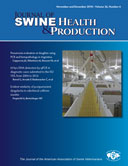Abstract:

General overview of the detection of Mycoplasma hyopneumoniae DNA by quantitative polymerase chain reaction in diagnostic cases submitted to the Iowa State University Veterinary Diagnostic Laboratory from 2004 to 2016
Gaurav Rawal, DVM; Paulo Arruda, DVM, PhD; Christopher Rademacher, DVM; Ran Bi, MS; Daniel C. L. Linhares, DVM, MBA, PhD
Complete article is available online.
PDF version is available online.
Mycoplasma hyopneumoniae (Mhp) is the etiologic agent of enzootic pneumonia and a major causative agent of the porcine respiratory disease complex. This study summarizes and describes the general diagnostic trends on Mhp detection by quantitative polymerase chain reaction (qPCR) in cases submitted to the Iowa State University Veterinary Diagnostic Laboratory from 2004 to 2016. The following variables were included in the analysis: animal age, geographic location, sample type, season, and submission year. The overall frequency of detection found was 27.04% and ranged from 17.9% to 40.7%. Lung homogenate and bronchial swabs had a greater Mhp qPCR detection rate than other sample types (P < .001) followed by bronchoalveolar lavage (P < .001), while oral fluids had the lowest Mhp detection rate (P < .001). The fall season had a greater percentage of positive Mhp qPCR results when compared to other seasons (P < .001), while spring had the lowest percentage. Finishing-age pigs had a greater percentage of Mhp qPCR detection when compared to other age groups (P < .001), while suckling pigs had the lowest percentage (P < .001).
Keywords: Mycoplasma hyopneumoniae, polymerase chain reactio, PCR
![]() Cite as: Rawal G, Arruda P, Rademacher C, et al. General overview of the detection of Mycoplasma hyopneumoniae DNA by quantitative polymerase chain reaction in diagnostic cases submitted to the Iowa State University Veterinary Diagnostic Laboratory from 2004 to 2016. J Swine Health Prod 2018;26(6):309-315.
Cite as: Rawal G, Arruda P, Rademacher C, et al. General overview of the detection of Mycoplasma hyopneumoniae DNA by quantitative polymerase chain reaction in diagnostic cases submitted to the Iowa State University Veterinary Diagnostic Laboratory from 2004 to 2016. J Swine Health Prod 2018;26(6):309-315.
Search the AASV web site for pages with similar keywords.
